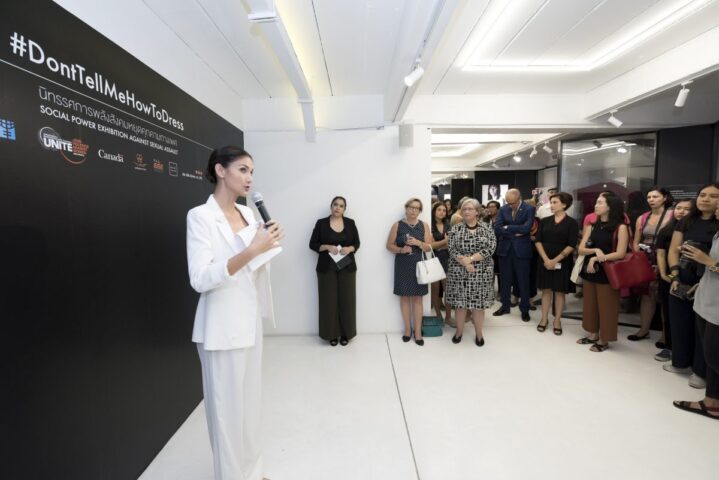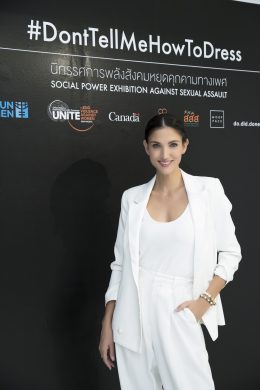
Don’t tell me how to dress

It was a perfect day for a water fight. The sun was out, not a cloud in the sky. Armed with a brand-new super-soaker, my valuables secured in a watertight pouch around my neck, and my girlfriends by my side, we headed off for some wet and wild fun. Songkran is a
They stood close to me, uncomfortably close, and suddenly I realised that there were about five of them, surrounding me and putting their hands all over me, down the front of my T-shirt, around my waist, on my backside and between my legs. All around me, the other partygoers were oblivious, spraying water, laughing and dancing. I felt helpless, violated and scared. I don’t remember if I managed to force my way out of their grasping hands or they decided to move to their next victim, but suddenly I found myself free and running as fast as I could through the crowd to hail down a taxi and escape. My friends told me later they had no idea where I had gone and had spent the next
This was before everyone had a smartphone. I was 17 years old. I never joined another Songkran party after that and to this day the sight of wet revellers jostling each other around on what should be a happy festival just leaves me with memories of that day. This happened during one of my favourite Thai festivals, in the middle of the day, with hundreds of people around. This is the sort of thing that happens a lot to women during Songkran, nearly 60% out of 1650 women surveyed recently by the Women and Men Progressive Foundation. Only 26% reported the incident to authorities because

So when I came across an article in the local paper in March of 2018 with the headline, “Don’t dress sexy, dept. tells women” in which the local authorities were telling women to avoid dressing in sexy outfits as they try to prevent sexual harassment or
I picked up my phone and recorded a clip in which I ranted in Thai about how utterly shortsighted, sexist and unfair this solution to curb sexual assault was. I briefly touched on my own experience that day many years ago, even though I was wearing a pair of three-quarter length jean shorts. I asked why was there no warning to the men who thought they could take advantage of women, or at least an outline of what of penalties they would face if caught doing so. How is that these authorities had only one solution to reducing this problem and that is to tell women how to dress? I added that this is exactly the kind of backward thinking that keeps this country in the dark ages when it comes to women’s rights. Then I posted it to my Instagram and Facebook accounts, threw my phone in my bag and thought nothing more of it. Within a few hours, the clip started to go viral, with hundreds and then thousands of people, mainly women, sharing and commenting on how they shared my exact sentiments, and even detailing their own stories of how they were harassed or assaulted during what should have been a fun and happy holiday.
By the next morning, my clip was all over the news. It had obviously hit a nerve with many Thai women. After reading their comments, and hearing their stories, I decided this is a conversation that was long overdue, and there is an underlying seething anger in this country over the injustice of women continually being blamed for sexual assault. I decided to create the hashtag #DontTellMeHowToDress and ask people to join me on social media in pushing back against what is an infringement on our basic human rights as women to dress and express ourselves, our right to privacy and safety and against the rampant victim-blaming that goes unchecked in our society. With the help of some of my celebrity friends, the local media and the overwhelming support of the Thai public, we were able to create a level of visibility and attention needed to become a proper social movement, and in a few days, my hashtags caught the attention of news media around the world, likening #DontTellMeHowToDress to that of #MeToo in the west.

After the initial online campaign, I decided to take the movement further and teamed up with the Thai government, UN Women, local NGOs and other partners to create the Social Power Exhibition Against Sexual Assault in which we showcased the actual clothing worn by women and girls at the time of their assault. By displaying the clothes, ranging from sweatpants to a toddler’s playsuit, the exhibition aimed to challenge the misconception that it is because of what women wear that is the main cause of rape and sexual assault. The exhibition also featured photographs of celebrities and influencers with the intention that they would be able to carry the message even further and shed more light on at issue that is most of the time kept in the dark, not spoken of and hidden away. Together with the online #DontTellMeHowToDress campaign
To
Too often, women do not seek help because when they do speak out, many feel ashamed and are blamed for the violence committed against them by the very people tasked with protecting them. What started as a spur of the moment rant on social media back last year has now become a life mission for me. I am inspired and emboldened by the countless stories and voices of women who have joined in this campaign and I am grateful for all the male champions who have also lent their



